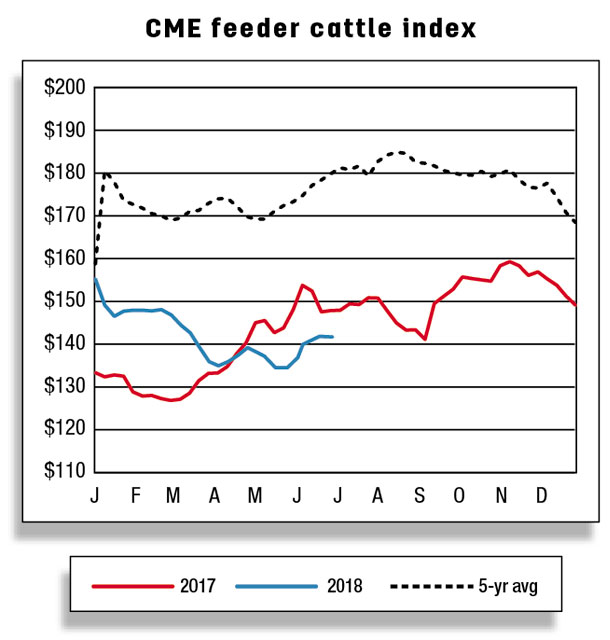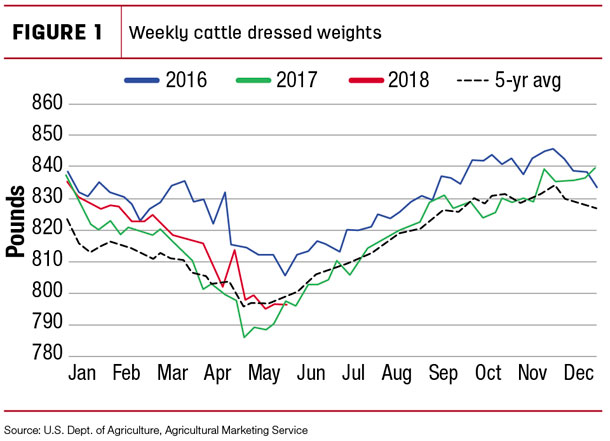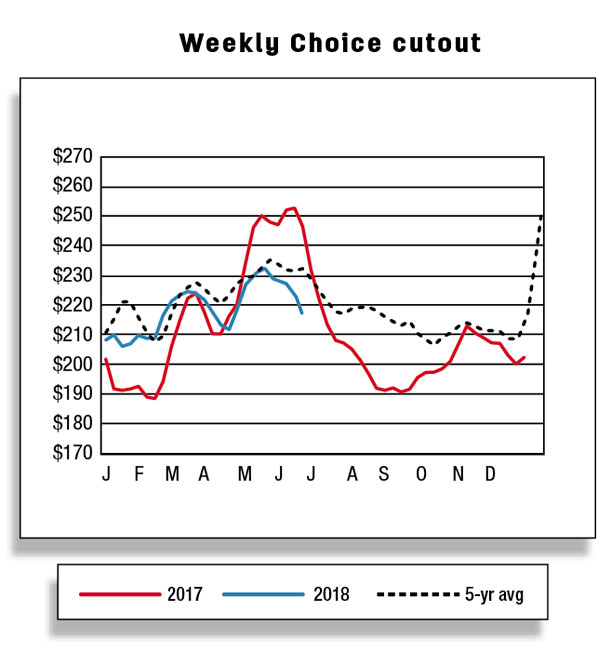Packers slaughtered 2.6 million head of cattle, 7 percent above April 2017, but the increase in part reflects one more weekday of slaughter in April this year. However, the report also indicated that the average cattle dressed weight dropped 13 pounds from March to April to 806 pounds, a 1.6 percent decline.

This is a similar month-to-month percentage drop for the same period in 2016 and 2017, but it is steeper than the five-year average.
The USDA Agricultural Marketing Service (AMS) report of Actual Slaughter Under Federal Inspection for the week ending June 2 indicates cattle dressed weights have continued to fall seasonally (Figure 1) to 1 pound below the same week last year.
 However, dressed weights typically bottom out around this time of year. Lighter dressed weights are expected to more than offset second-quarter increased slaughter of steers, heifers and cows. The forecast for 2018 production in the second half of this year was reduced slightly on lighter anticipated weights.
However, dressed weights typically bottom out around this time of year. Lighter dressed weights are expected to more than offset second-quarter increased slaughter of steers, heifers and cows. The forecast for 2018 production in the second half of this year was reduced slightly on lighter anticipated weights.
As a result, this month’s forecast for 2018 beef production is 27.1 billion pounds, down 90 million pounds from last month. The forecast for 2019 production was left unchanged from last month.
Fed cattle prices support strong packer margins
The weekly average fed steer price in the five-area marketing region (Texas/Oklahoma/New Mexico, Kansas, Nebraska, Colorado, Iowa/Minnesota) likely reached a second-quarter peak of $124.81 per hundredweight (cwt) for the week ending May 6. During that week, the price was nearly $20 above the asking price of the June live cattle contract.
Although the spread narrowed during the month, the prospect of lower prices during June likely influenced feedlot operations to promptly market their cattle. In turn, it likely allowed packers to be price setters. For the week ending June 10, fed steer prices were $114.66 per cwt, up $4 from the previous week, but down more than $10 below the first week of May.
 Combined with firm beef demand, the drop in prices has fueled record margins for packers. These very strong margins are likely supporting packer willingness to slaughter larger numbers of cattle.
Combined with firm beef demand, the drop in prices has fueled record margins for packers. These very strong margins are likely supporting packer willingness to slaughter larger numbers of cattle.
According to the AMS report of Estimated Weekly Meat Production Under Federal Inspection for the week ending June 9, the number of cattle slaughtered to date was 14.1 million head, up 3.1 percent above last year. The second-quarter price forecast for fed steers is $116 to $119 per cwt. Price forecasts for third and fourth quarters in 2018 and for all of 2019 were left unchanged.
Beef exports strong through April
Beef exports had a strong showing in April as exports were 16.1 percent above last year at 254 million pounds. It was the largest monthly year-over-year percentage increase to date this year, supported mainly by higher exports to South Korea (+63.1 percent), Mexico (+30.6 percent), Taiwan (+19 percent), Canada (+11.1 percent) and Japan (+8.8 percent). Hong Kong remains a strong destination despite U.S. exports having dropped 5.7 percent year over year in April.
Year to date, exports to Hong Kong remain 22.2 percent above a year ago. Based on export sales reports through May, overseas demand remains strong. The continued demand by markets in Asia and North America has helped drive increased cumulative monthly U.S. exports. As a result, the 2018 beef export forecast was raised in the second quarter by 15 million pounds for a full-year total of 3.05 billion pounds.

During April, U.S. beef imports were down 5.8 percent from a year earlier, mainly on fewer shipments from Brazil, Mexico and Australia. However, from recent import data from AMS, there would appear to be stronger-than-expected U.S. demand for lean meat from Oceania and North and Central America.
As a result, the import forecast was revised higher by 10 million pounds in each of the second and third quarters for a full-year total of 3.052 billion pounds. The forecasts for 2019 beef exports and imports were left unchanged from last month. ![]()
References omitted but are available upon request. Click here to email an editor.
Russell Knight is a market analyst with the USDA – ERS. Email Russell Knight.






